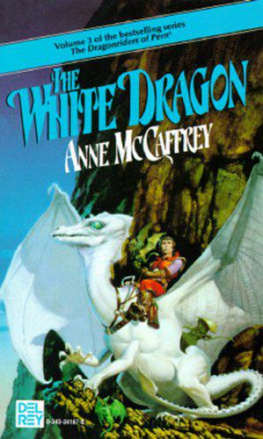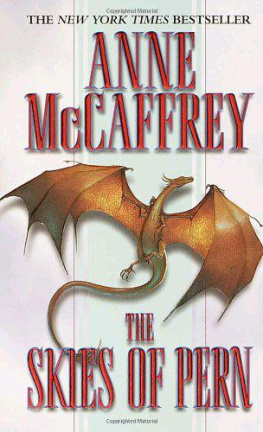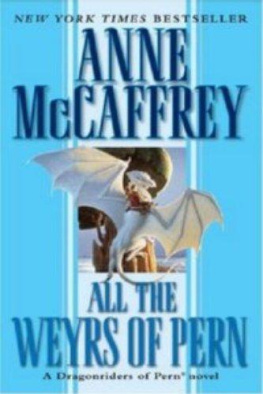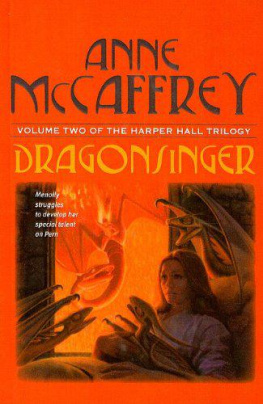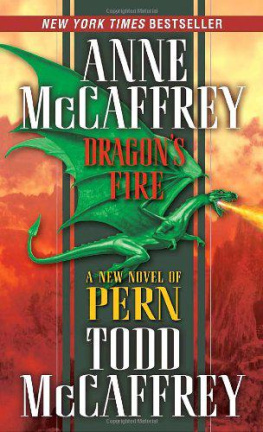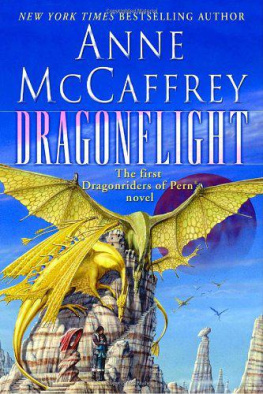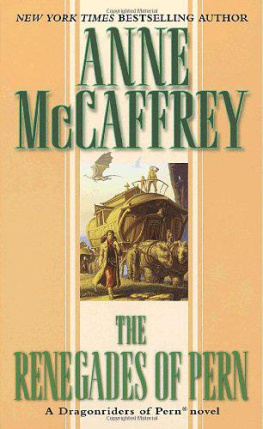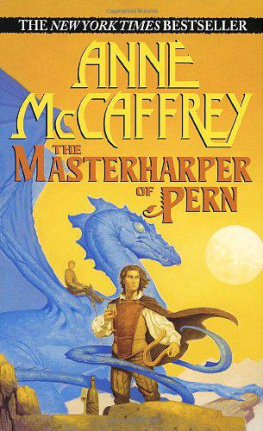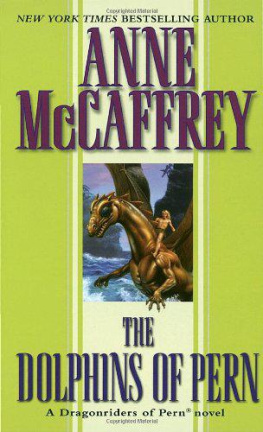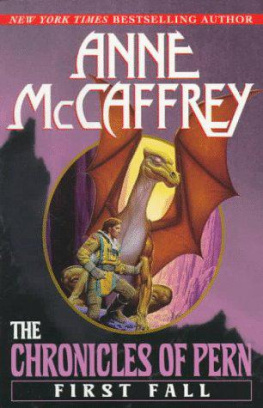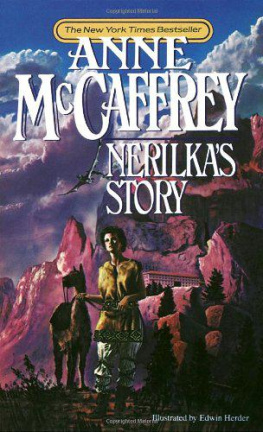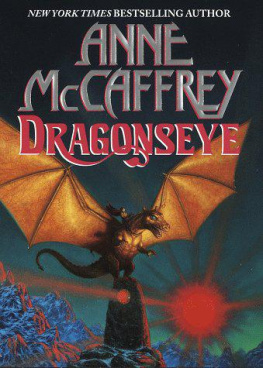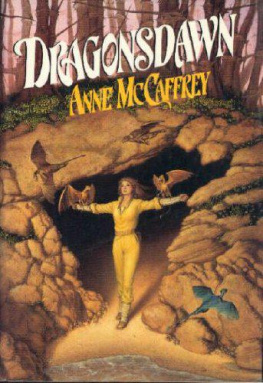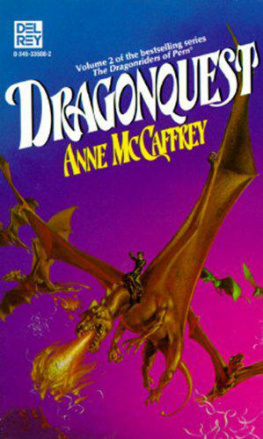Anne McCaffrey - The White Dragon
Here you can read online Anne McCaffrey - The White Dragon full text of the book (entire story) in english for free. Download pdf and epub, get meaning, cover and reviews about this ebook. year: 1986, publisher: Del Rey, genre: Detective and thriller. Description of the work, (preface) as well as reviews are available. Best literature library LitArk.com created for fans of good reading and offers a wide selection of genres:
Romance novel
Science fiction
Adventure
Detective
Science
History
Home and family
Prose
Art
Politics
Computer
Non-fiction
Religion
Business
Children
Humor
Choose a favorite category and find really read worthwhile books. Enjoy immersion in the world of imagination, feel the emotions of the characters or learn something new for yourself, make an fascinating discovery.
- Book:The White Dragon
- Author:
- Publisher:Del Rey
- Genre:
- Year:1986
- Rating:3 / 5
- Favourites:Add to favourites
- Your mark:
- 60
- 1
- 2
- 3
- 4
- 5
The White Dragon: summary, description and annotation
We offer to read an annotation, description, summary or preface (depends on what the author of the book "The White Dragon" wrote himself). If you haven't found the necessary information about the book — write in the comments, we will try to find it.
The White Dragon — read online for free the complete book (whole text) full work
Below is the text of the book, divided by pages. System saving the place of the last page read, allows you to conveniently read the book "The White Dragon" online for free, without having to search again every time where you left off. Put a bookmark, and you can go to the page where you finished reading at any time.
Font size:
Interval:
Bookmark:
The White Dragon
By Anne McCaffrey
Serve these unusual animals. These dragons-named for the mythical Terran beast they resembled-had two valuable characteristics: they could get from one place to another instantaneously and, after chewing a phosphine-bearing rock, they would emit a flaming gas. Because the dragons could fly, they were able to char Thread in midair, and then escape from its ravages.
It took generations to develop to the fullest the potential of these dragons. The second phase of the proposed defense against the deadly incursions would take even longer. For Thread, a space-traveling mycorrhizoid spore, with mindless voracity devoured all organic matter and, once grounded, burrowed and proliferated with terrifying speed. So a symbiote of the same strain was developed to counter this parasite, and the resulting grub was introduced into the soil of the southern continent. The original plan was that the dragons would be a visible protection, charring Thread while it was still sky borne and protecting the dwellings and the livestock of the colonists. The grub-symbiote would protect vegetation by devouring any Thread that managed to evade the dragons' fire.
The originators of the two-stage defense did not allow for change or for hard geological fact. The southern continent, overtly more attractive than the harsher northern land, proved unstable and the entire colony was eventually forced to move north to seek refuge from the Threads in the natural caves on the continental shield rock of the north.
The original Fort, constructed in the eastern face of the Great West Mountain Range, soon grew too small to hold the colonists. Another settlement was started slightly to the north, alongside a great lake conveniently formed near a cave-filled cliff. But Ruatha Hold, as the settlement was called, became overcrowded within a few generations.
Since the Red Star rose in the east, the people of Pern decided to establish a holding in the eastern mountains, provided a suitable cavesite could be found. Only solid rock and metal, both of which were in distressingly short supply on Pern, were impervious to the burning score of Thread.
The winged, tailed, fire-breathing dragons had by then been bred to a size that required more spacious accommodations than the cliffside holds could provide. But ancient cave-pocked cones of extinct volcanoes, one high above the first Fort, the other in the Benden Mountains, proved to be adequate and required only a few improvements to be made habitable. However, such projects took the last of the fuel for the great stonecutters, which had been programmed only for regular mining operations, not for wholesale cliff excavations. Subsequent holds and weyrs had to be hand-hewn.
The dragons and their riders in their high places and the people in their cave holds went about their separate tasks, and each developed habits that became custom, which solidified into tradition as incontrovertible as law.
Then came an interval of two hundred Turns of the planet Pern around its primary-when the Red Star was at the other end of its erratic orbit, a frozen, lonely captive. No Thread fell on Pern. The inhabitants erased the depredations of Thread and grew crops, planted orchards from precious seed brought with them, thought of reforestry for the slopes denuded by Thread. They even managed to forget that they had once been in grave danger of extinction. Then the Threads fell again when the wandering planet returned for another orbit around Pern, bringing fifty years of attack from the skies. The Pernese once again thanked their ancestors, now many generations removed, for providing the dragons who seared the dropping Thread midair with their fiery breath.
Dragonkind, too, had prospered during that interval and had settled in four other locations, following the master plan of interim defense.
The significance of the southern hemisphere-and of the grub-had been lost in the immediate struggle to establish new settlements. Recollections of Earth receded further from Pernese history with each successive generation until memory of their origins degenerated into legend or myth and passed into oblivion.
By the Third Pass of the Red Star, a complicated socio-political-economic structure had been developed to deal with this recurrent evil. The six Weyrs, as the old volcanic habitations of the dragonfolk were called, pledged themselves to protect Pern, each Weyr haying a geographical section of the northern continent literally under its wing. The rest of the population agreed to tithe to support the Weyrs since these fighters, these dragonmen, did not have arable land in their volcanic homes. They could not afford to take time away from nurturing their dragons to learn other trades during peacetime, nor could they take time away from protecting the planet during Passes.
Settlements, called Holds, developed wherever natural caves were found-some, of course, more extensive or strategically placed than others. It took a strong man to hold frantic, terrified people in control during Thread attacks; it took wise administration to conserve victuals when nothing could be safely grown, and it took extraordinary measures to control population and keep it productive and healthy until such time as the menace passed.
Men with special skills in metalworking, weaving, animal husbandry, farming, fishing, mining formed Crafthalls in each large Hold and looked to one Mastererafthall where the precepts of their craft were taught and craft skills were preserved and guarded from one generation to another. One Lord Holder could not deny the products of the Crafthall situated in his Hold to others, since the Crafts were deemed independent of a Hold affiliation. Each Craftmaster of a hall owed allegiance to the Master of that particular craft-an elected office based on proficiency in that craft and administrative ability. The Mastercraftsman was responsible for the output of his halls and the distribution, fair and unprejudiced, of all craft products on a planetary rather than parochial basis.
Certain rights and privileges accrued to different leaders of Holds and Masters of Crafts and, naturally, to the dragonriders whom all Pern looked to for protection during the Threadfalls.
On occasion, the conjunction of Rukbat's five natural planets would prevent the Red Star from passing close enough to Pern to drop its fearful spores. To the Pernese these were Long Intervals. During one such Interval, the grateful people prospered and multiplied, spreading out across the land, carving more holds on of solid rock, just in case Thread returned. But they became so busy with their daily pursuits that they preferred to think that the Red Star had indeed passed beyond any danger to them.
No one realized that only a few dragons remained to take to the skies and that only one Weyr of dragonriders was left on Pern. Since the Red Star wasn't due to return for a long, long while, if ever, why worry? Within five generations, the descendants of the heroic dragonmen fell into disfavor; the legends of past braveries and the very reason for their existence fell into disrepute.
Volume One of THE DRAGONRIDERS OF PERN:
DRAGONFLIGHT begins when the Red Star, obeying natural forces, began to spin closer to Pern, winking with a baleful red eye on its ancient victim. One man, P'lar, rider of the bronze dragon Mnementh, believed that the ancient tales had truth in them. His halfbrother, F'nor, rider of brown Canth, listened to his arguments and believed in them. When the last golden egg of a dying queen dragon lay hardening on the Benden Weyr Hatching Ground, F'lar and F'nor saw an opportunity to gain control of the Weyr. Searching for a strong-minded woman to ride the soon-to-be-hatched queen, F'lar and F'nor discovered Lessa, the only surviving member of the proud Bloodline of Ruatha Hold. She Impressed young Ramoth, the new queen, and became Weyrwoman of Benden. Then F'lar's bronze Mnementh flew the young queen in her first mating, and F'lar became Weyrieader of Pern's remaining dragonriders.
Next pageFont size:
Interval:
Bookmark:
Similar books «The White Dragon»
Look at similar books to The White Dragon. We have selected literature similar in name and meaning in the hope of providing readers with more options to find new, interesting, not yet read works.
Discussion, reviews of the book The White Dragon and just readers' own opinions. Leave your comments, write what you think about the work, its meaning or the main characters. Specify what exactly you liked and what you didn't like, and why you think so.

